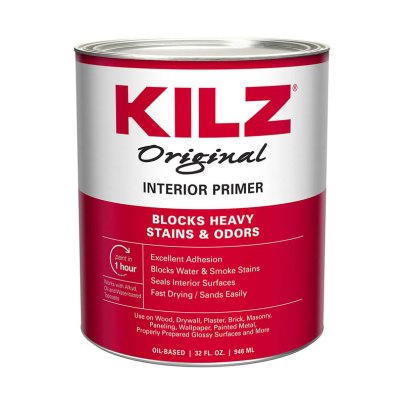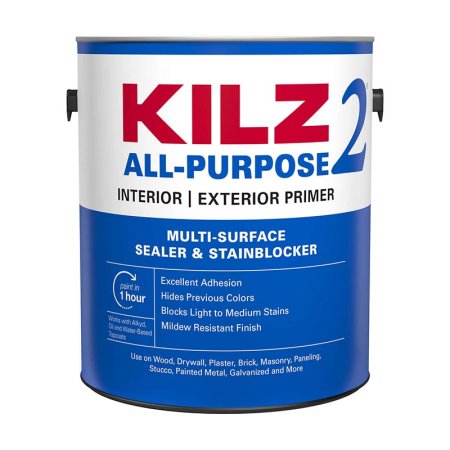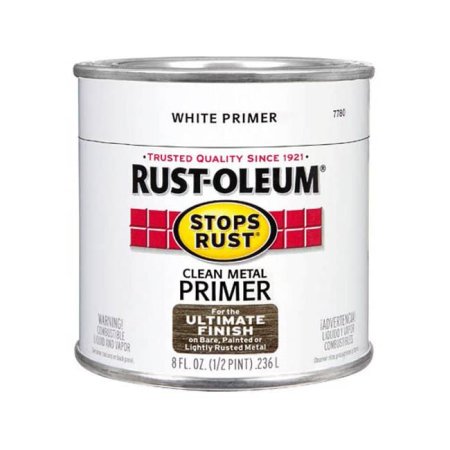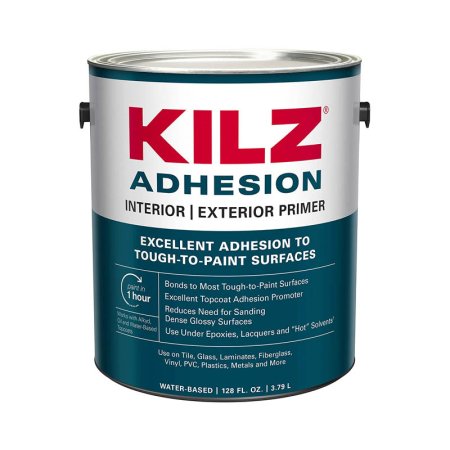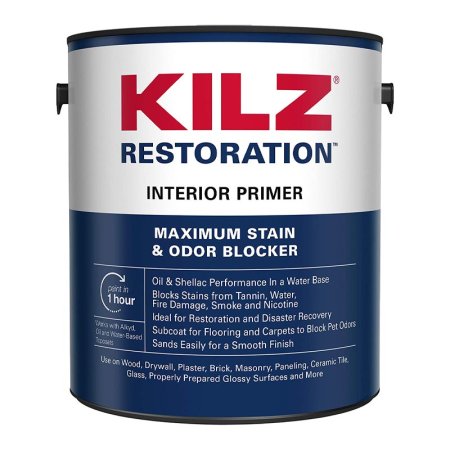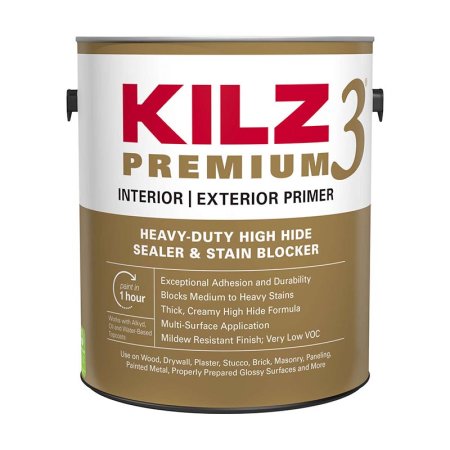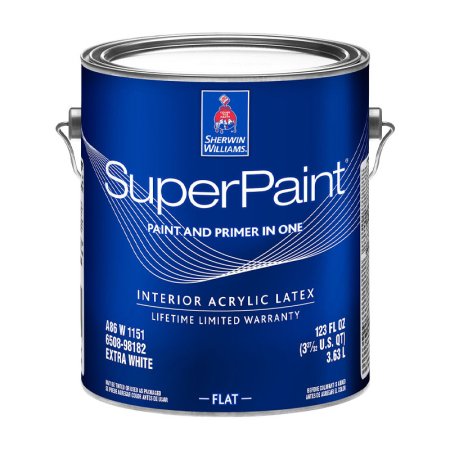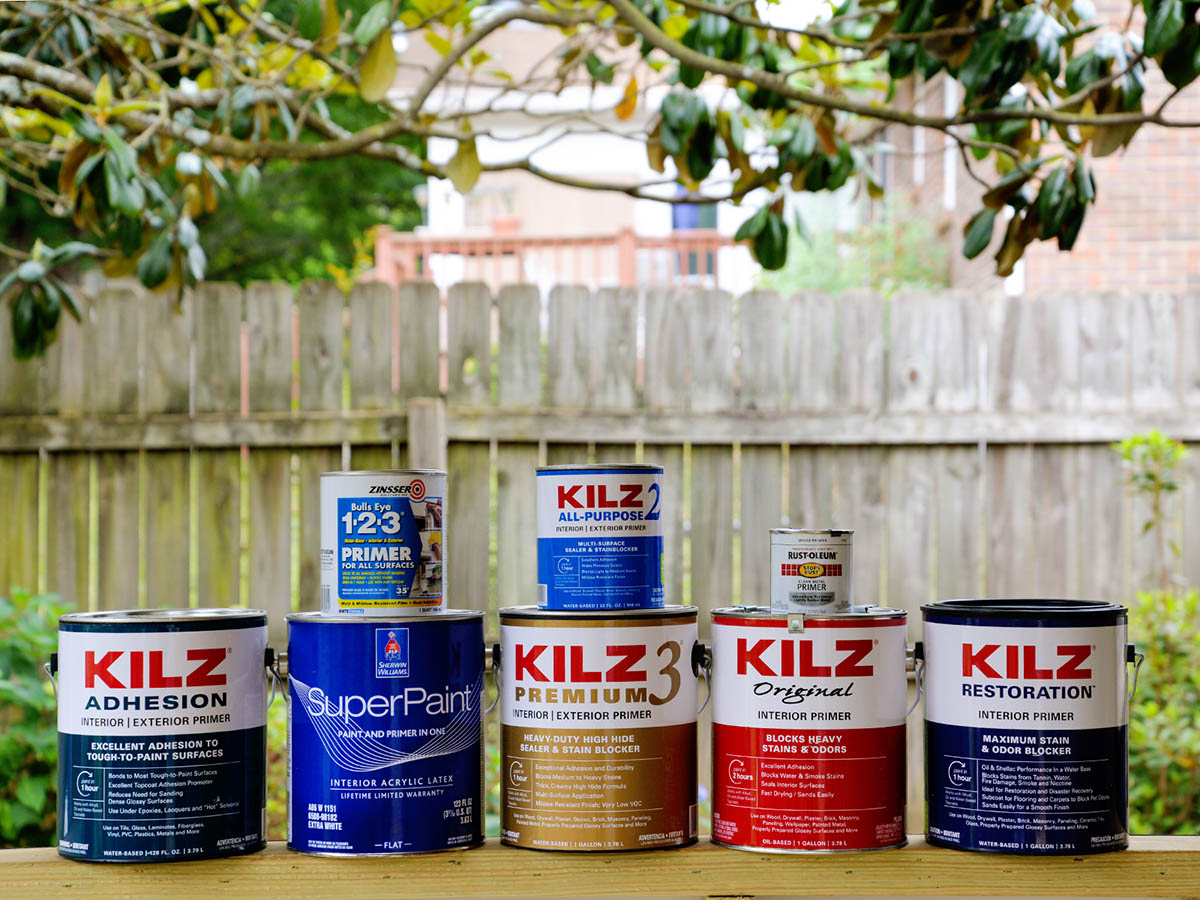
We may earn revenue from the products available on this page and participate in affiliate programs. Learn More ›
Whether you’re painting the living room or a patio table, applying a prep coat of primer to the surface can improve adherence, prevent peeling, and reduce the number of coats needed to finish the job. While all primers contain more resins and less pigment than paint, formulas vary from product to product. We tested some of the most popular options to find out which primer works best for different situations. Our number one pick is Rust-Oleum’s Zinsser Bulls Eye with its low odor and ability to work on multiple surfaces.
The right primer for your project depends on the environment you’ll be working in, the surface you’ll be painting, and your preferences for the time frame of the job and its final look. Read on to find out what makes a quality paint primer and why the below options rank as our top favorites among the best paint primers we tested.
- BEST OVERALL: Rust-Oleum Zinsser Bulls Eye 1-2-3 Water-Base Primer
- BEST BANG FOR THE BUCK: Kilz Original Interior Primer
- BEST ALL-PURPOSE: Kilz 2 All-Purpose Interior/Exterior Primer
- BEST FOR METAL: Rust-Oleum Clean Metal Primer
- BEST FOR GLOSSY SURFACES: Kilz Adhesion Interior/Exterior Primer
- BEST FOR ODOR BLOCKING: Kilz Restoration Interior Primer
- BEST FOR EXTERIOR: Kilz 3 Premium Interior/Exterior Primer
- BEST FOR INTERIOR WALLS: Sherwin-Williams SuperPaint Interior Acrylic Latex
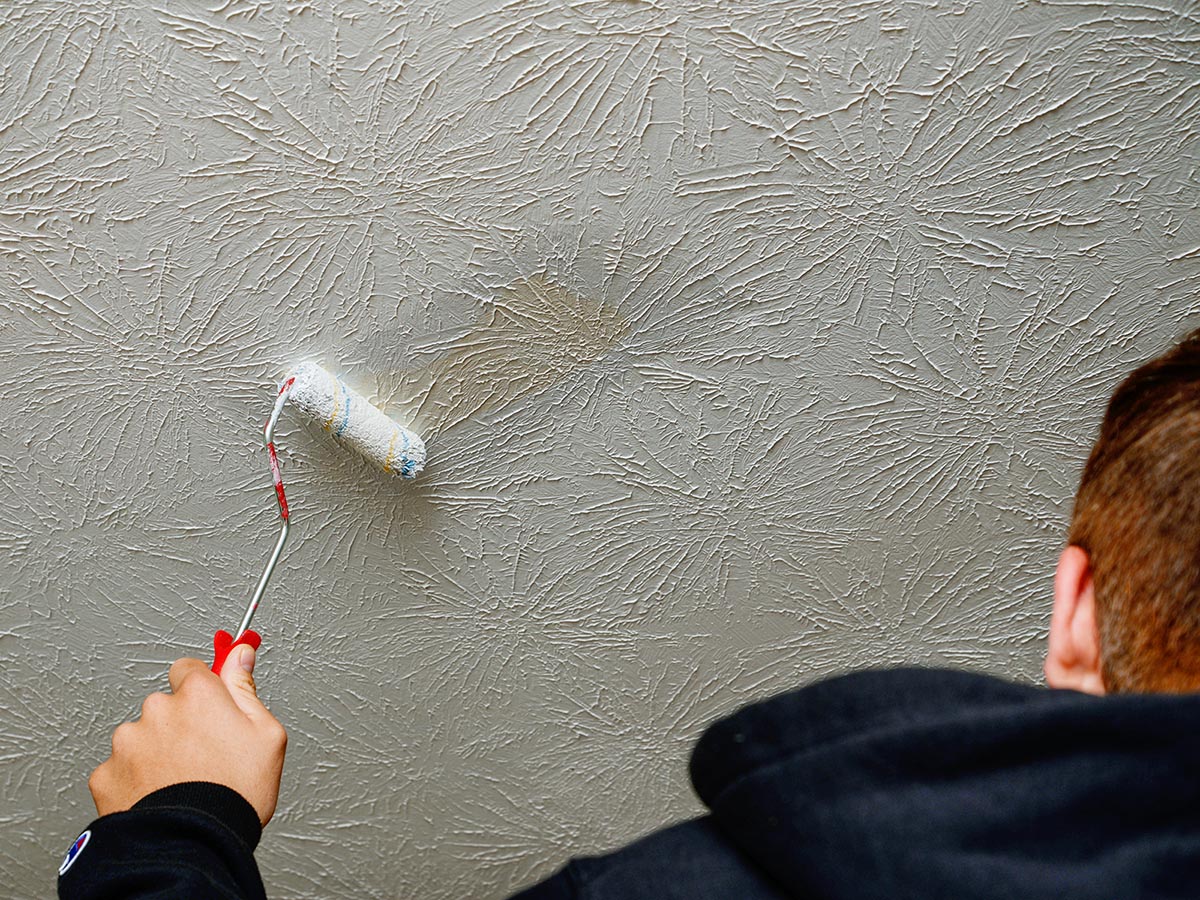
Product Comparison
| Interior/Exterior | Recoat Time | Base Material | |
| Rust-Oleum Zinsser Bulls Eye 1-2-3 Water-Base Primer | Both | 1 hour | Water-based acrylic |
| Kilz Original Interior Primer | Interior | 2 hours or less | Oil |
| Kilz 2 All-Purpose Interior/Exterior Primer | Both | 1 hour | Water |
| Rust-Oleum Clean Metal Primer | Both | 24 hours | Oil |
| Kilz Adhesion Interior/Exterior Primer | Both | 1 hour | Water |
| Kilz Restoration Interior Primer | Interior | 1 hour | Water |
| Kilz 3 Premium Interior/Exterior Primer | Both | 1 hour | Latex |
| Sherwin-Williams SuperPaint Interior Acrylic Latex | Interior | 1 hour | Latex |
Our Top Picks
We spent hours narrowing the paint primer market and testing the top-rated products. One or more of these recommendations for the best paint primer may suit your specific needs.
Best Overall
Rust-Oleum Zinsser Bulls Eye 1-2-3 Water-Base Primer
What We Like
- Low-VOC and low-odor formula
- Mold- and mildew-resistant
- Works on multiple surface types
What We Don’t Like
- Thin viscosity; second coat may be required for proper coverage
Product Specs
- Interior/exterior: Both
- Recoat time: 1 hour
- Base material: Water-based acrylic
Rust-Oleum is well known for its protective paints and coatings. Its Zinsser Bulls Eye 1-2-3 water-base primer is an all-purpose primer-sealer that sticks to various surfaces without sanding and works with any top coat. The brand is regarded as one of the top producers of rust-preventive paints.
The primer is low odor, low in volatile organic compounds (VOCs), and provides excellent coverage on interior and exterior surfaces. It’s made from water-based acrylic and is designed to resist blistering, peeling, and mold and mildew growth. The primer is tintable and available in white or gray. It’s also available in spray-paint form.
We tested this primer on multiple surfaces, including drywall, wood, metal, and plastic. It readily stuck to all of those surfaces and provided a textured finished surface that easily held onto a top coat of paint. The primer did not completely block the water stain on drywall, but we expected that—most white primers do not. We thought the paint was thin and needed two coats on all surfaces to ensure an even, smooth top coat. Overall, we liked this primer’s versatility of use on multiple surfaces, making it our top choice.
Get the Rust-Oleum Zinsser paint primer at Amazon or Ace Hardware.
Best Bang for the Buck
Kilz Original Interior Primer
What We Like
- Effectively blocks stains and odors
- Applies smoothly and evenly
- Lower-VOC formula
What We Don’t Like
- Strong odor
Product Specs
- Interior/exterior: Interior
- Recoat time: 2 hours or less
- Base material: Oil
Kilz is a trusted paint brand, especially for primers. Kilz Original interior primer is the company’s flagship primer designed to block most heavy interior stains on wood, drywall, plaster, paneling, wallpaper, masonry, brick, and painted metal. It also works on properly prepared glossy surfaces.
The primer is oil-based but can be used as a base coat for latex and oil paints. Kilz is our go-to primer for tough stains in our household. Previously, we had only used the spray-can version but found that the can version works just as well. We tested the primer on water stains on our drywall and as a base coat on various materials, including wood, brick, and metal. The primer adhered well to porous surfaces, but we did need to sand the metal before priming.
The white primer paint did a decent job blocking light-colored stains. However, in our experience with trying to hide stubborn stains on drywall, the primer works best at hiding stains when tinted gray.
Although it is available in a lower-VOC formula, it is not low VOC and the odor was strong. We recommend using a respirator or working in a well-ventilated area when using this primer. Overall, Kilz Original is a solid performer, and we highly recommend it for any ventilated interior primer application.
Get the Kilz Original paint primer at Ace Hardware.
Best All-Purpose
Kilz 2 All-Purpose Interior/Exterior Primer
What We Like
- Minimal odor
- Mildew-resistant finish
- Easy soap-and-water cleanup
- Low-VOC formula
What We Don’t Like
- Only blocks light to medium stains
Product Specs
- Interior/exterior: Both
- Recoat time: 1 hour
- Base material: Water
Kilz 2 all-purpose interior/exterior primer is a general-purpose primer well suited for use on various DIY projects. This water-based primer has a drastically lower VOC content than the Original Kilz Primer, and it works under or over water-based or oil-based paints. It blocks light to medium stains and mild odors, and it leaves a mildew-resistant finish.
Kilz 2 all-purpose primer works well for general-purpose priming and sealing needs. In testing, it left a smooth base coat on drywall and bare wood. It did a moderate job blocking dark stains on walls, but it effectively blocked lighter stains like pencil marks, minor scuffs, and markers. We recommend using Kilz 2 for priming old walls before repainting or for any exterior surface as a base coat for exterior paint. It’s also handy to use a primer for craft painting projects.
Get the Kilz 2 paint primer at Lowe’s, Ace Hardware, or The Home Depot.
Best for Metal
Rust-Oleum Clean Metal Primer
What We Like
- Prevents rust from growing in some areas
- Suitable for both indoor and outdoor use
- Weather- and corrosion-resistant
What We Don’t Like
- Metal surfaces should be sanded beforehand
Product Specs
- Interior/exterior: Both
- Recoat time: 24 hours
- Base material: Oil
Rust-Oleum Clean Metal primer is formulated to cover lightly rusted metals as well as bare and previously painted metals. It’s weather- and corrosion-resistant and bonds tightly to exterior/interior surfaces like wood, metal, concrete, and masonry.
This primer is designed primarily for use on metal, but it works well on other surfaces. It did a good job blocking rust stains on a metal bench we refinished, and it provided a smooth surface for a top coat. The only real drawback of this primer was that the smooth surfaces required prep work before use—smooth, hard, or glossy finishes need sanding for the primer to adhere. However, after applying onto sanded metal, it did form a durable finish, and the top coat went on beautifully.
Get the Rust-Oleum metal paint primer at Amazon, Ace Hardware, or The Home Depot.
Best for Glossy Surfaces
Kilz Adhesion Interior/Exterior Primer
What We Like
- Bonds to glossy surfaces without sanding
- Can be used on products containing xylene or other solvents
- Easy soap-and-water cleanup after use
What We Don’t Like
- Not for wet floors or horizontal surfaces
Product Specs
- Interior/exterior: Both
- Recoat time: 1 hour
- Base material: Water
Kilz Adhesion interior/exterior primer is formulated to bond to various tough-to-paint surfaces such as PVC, vinyl, glass, tile, and glazed brick. The water-based primer offers the same stain- and odor-blocking properties as the other Kilz primers. Unlike the other primers in the Kilz line, Adhesion does not require sanding a glossy surface before primer application.
Since this primer is virtually identical in its stain and odor properties to the others in the Kilz lines, we primarily tested its ability to stick to slick surfaces. We applied the primer to plastic, metals, and glazed ceramic. We did not sand the surface before application. It did adhere to the surfaces pretty well, but we did find that applying the primer in thin, multiple layers produced better results. Although it took at least two coats, we prefer to paint two coats rather than sanding the entire surface first.
Get the Kilz Adhesion paint primer at Amazon.
Best for Odor Blocking
Kilz Restoration Interior Primer
What We Like
- Minimal odor and low-VOC formula
- Easy soap-and-water cleanup
- Provides a smooth finish
What We Don’t Like
- Does not block or cover heavy or prominent stains
Product Specs
- Interior/exterior: Interior
- Recoat time: 1 hour
- Base material: Water
Water, mold, and rust stains are tough to cover, but odors are even harder to conceal. Smoke, pet urine, and food odors often require using an oil-based or shellac-based primer to seal them into the surface before painting. However, Kilz Restoration interior primer offers the same performance as oil-based primers but with the easy cleanup convenience of water-based paint.
Like the other primers offered by Kilz, this primer did an adequate job of covering most light to medium stains. However, Kilz Restoration shines as an odor blocker. We tested this primer drywall in a room where smokers previously resided. The primer went on smoothly and sealed in the odor. Once the top coat was applied, there was no hint of the smell. It did a moderate job concealing old water stains, but we expected that.
Since this primer is mainly formulated for odor blocking, we suggest only using this primer for that purpose. Kilz Original primer is a better stain blocker.
Get the Kilz Restoration paint primer at Amazon, Ace Hardware, or The Home Depot.
Best for Exterior
Kilz 3 Premium Interior/Exterior Primer
What We Like
- Blocks most medium to heavy stains
- No-VOC formula
- Great in moisture-prone areas
What We Don’t Like
- Not meant for applying to glossy surfaces
Product Specs
- Interior/exterior: Both
- Recoat time: 1 hour
- Base material: Latex
Kilz 3 Premium interior/exterior primer is formulated to minimize problems caused by color changes, minor stains, surface textures, and porosity differences. This primer offers excellent adhesion, a mildew-resistant coating, and seals interior and exterior surfaces for a uniform finish.
In testing, we found that this primer did an excellent job sealing new wood framing on our covered deck. It left an ultrasmooth finish, and the top coat went on smoothly. The primed and painted wood has been through a few rainstorms and high humidity conditions for a few weeks, and the surface still looks amazing.
As a stain blocker, it did a decent job covering up an older painted surface with minor mold and dirt discoloration. The only con we found with this primer was that it’s not made to adhere to glossy surfaces without preparation. However, it’s an excellent primer for exterior use because it sticks readily to plaster, paneling, masonry, brick, and painted metal without issue.
Get the Kilz 3 Premium paint primer at Lowe’s, Ace Hardware, or The Home Depot.
Best for Interior Walls
Sherwin-Williams SuperPaint Interior Acrylic Latex
What We Like
- Thick paint goes on smoothly
- Can also be used on ceilings
- Tintable in Sherwin-Williams’ full color options
- Low-VOC formula
What We Don’t Like
- Expensive compared to similar options
Product Specs
- Interior/exterior: Interior
- Recoat time: 1 hour
- Base material: Latex
Sherwin-Williams SuperPaint is the brand’s paint-and-primer combo available in interior and exterior formulations. The interior version is designed for one coat coverage on drywall, trim, and ceilings. SuperPaint creates a lasting finish and a surface that holds up to scrubbing.
We have used SuperPaint as our primary wall paint for years. It’s thicker than most interior paints, which allows it to cover in fewer coats than cheaper paints. The flat finish is perfect for ceilings, too. We could achieve solid coverage on walls in two coats, even over darker paint. Although we were able to cover a similar color wall in one coat in the past, we think it looks better with two coats of paint. The only con we have with this paint is that it’s expensive. However, Sherwin-Williams often offers promos that can help offset the cost.
Get the Sherwin-Williams paint primer at Sherwin-Williams.
Jump to Our Top Picks
How We Tested the Best Paint Primers
We tested each paint primer according to established rubrics, including how easy it was to apply, how well it adhered to various surfaces, and its stain- and odor-blocking abilities. We rated each primer based on these rubrics on a scale between 0 and 4 to determine a score. Lastly, we tested the primer’s durability and how attractive the final finish appeared on each surface.
We applied each primer to metal, masonry, drywall, and wood surfaces. The drywall surfaces included water stains, mildew, and lingering smoke odors. We applied two coats of primer to each surface and allowed it to dry for an hour, and then followed up with a flat white top coat to determine if there was any bleedthrough of stains and to judge the smoothness of the top coat.
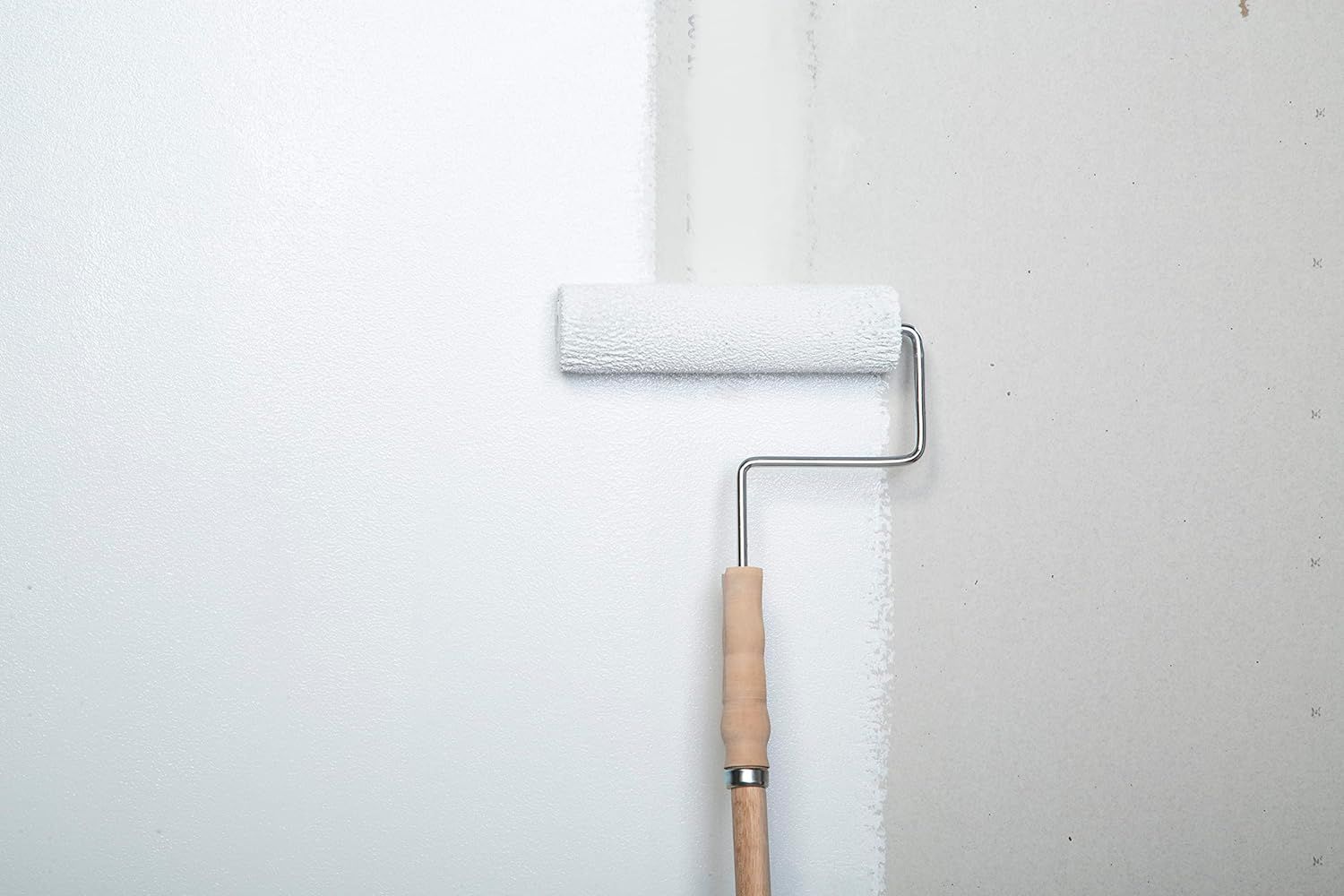
What to Consider When Choosing a Paint Primer
When choosing a primer for your project, there are several features to consider. The best paint primer options efficiently cover multiple surfaces, block stains, and ensure an even, smooth top coat. Here are more details about important features to consider when choosing a paint primer.
Project Environment
Paint primers come in three formulas: interior/exterior, exterior, and interior.
Interior/exterior primers are suited for indoor and outdoor use, while exterior primers are designed for outdoor use only. Both contain additives that stave off UV-related fading and moisture-related mold issues; they also add flexibility to withstand frequent outdoor temperature changes, preventing the paint from peeling or cracking.
Interior primers, formulated without exterior additives, are only suitable for indoor use. Interior/exterior primer is the best bet for doing a range of painting jobs, indoors and out. Plus, choosing a primer that works inside and outside saves on the costs of buying separate interior and exterior products.
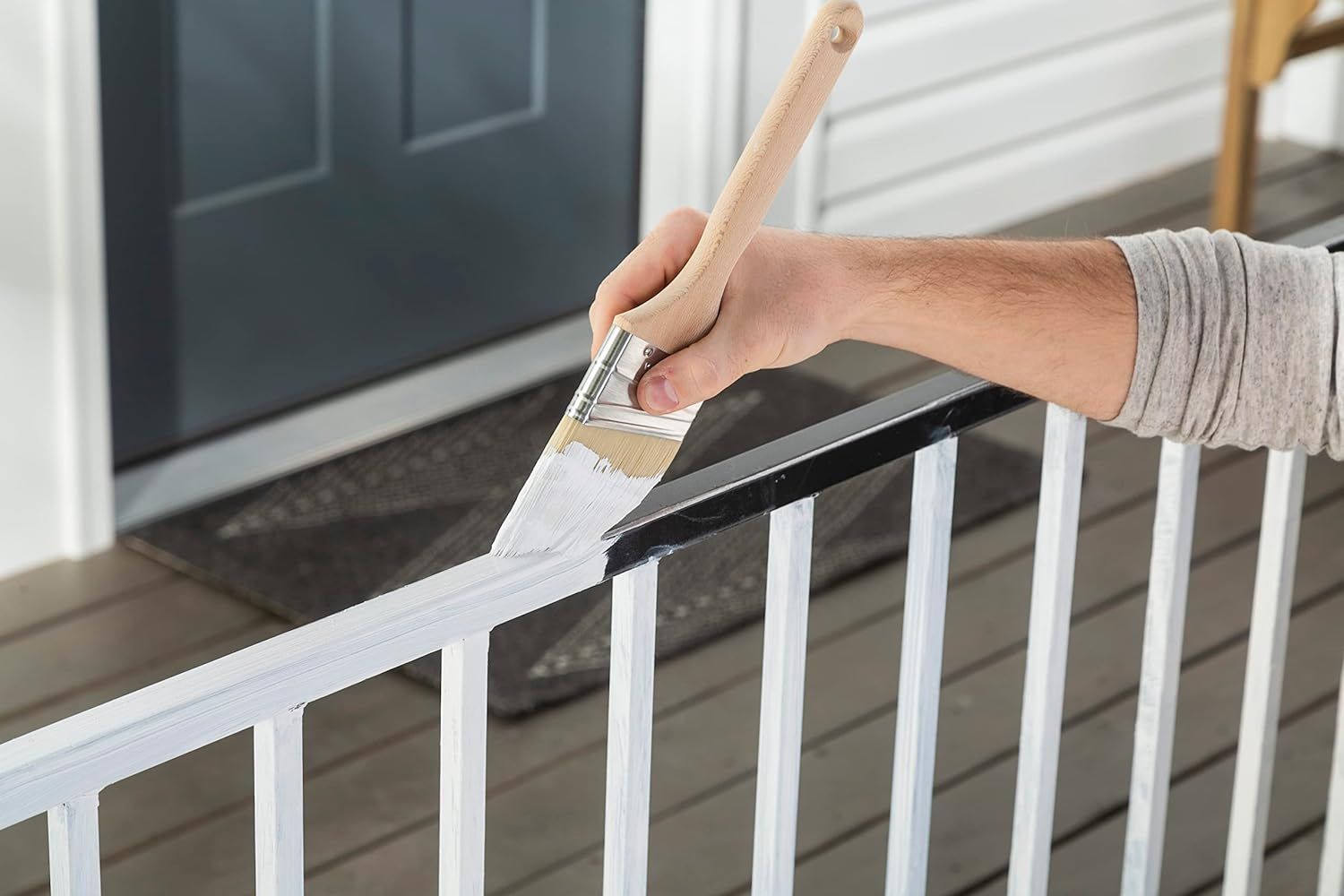
Surface
Each type of primer may adhere better to different surfaces. The following details the best primer type for common household surfaces:
- Bare wood: Apply an oil-based or latex primer to wood that has never been stained or painted to help seal the porous surface. Keep in mind that oil-based primers tend to emit more VOCs (smelly pollutants) than do latex primers.
- Drywall: Apply a latex primer to drywall, as an oil-based primer can raise the grain and make the surface look uneven.
- Stain-prone surfaces: Use a stain-blocking primer on stained wood, bare wood with high tannin content that can bleed out (e.g., cedar or redwood), interior walls with water or smoke stains, or cabinets/trim with grease stains. It will cover stains and keep them from bleeding into and discoloring top coats.
- Choose latex stain-blocking primer if the stains are solvent-based (e.g., crayons or grease).
- Choose an oil-based stain-blocking primer if the stain is water-based (e.g., water-based wood stain, smoke, or tannin).
- Painted wood: An oil-based primer is usually best for painted wood that shows chalking (a chalky powder on the surface as the paint binder degrades) or chipping; it will dry into a denser, smoother foundation to minimize these imperfections.
- Metal: Choose a rust-resistant oil-based primer on metals such as aluminum to avoid the formation of rust, which the water in latex primer can promote.
- Glossy surfaces: Bonding primer, formulated to stick to glossy surfaces, is a must for the slick likes of glass, plastic, or glazed tile.
Dedicated Primer vs. Paint-and-Primer in One
Self-priming paints—also known as paint-and-primer combo products—let users prime and paint a surface in a single step. But these two-in-one products are only recommended if all of the following are true:
- You’re not painting bare or stained wood.
- Your painting surface has no stains or signs of peeling.
- You’re repainting a previously painted surface in the same color or going from a lighter to a darker paint color.
Choose separate paint and primer to improve paint adhesion in the following situations:
- You’re painting bare or stained wood.
- You’re painting over a surface that has stains or is peeling.
- You’re switching from a darker to a lighter paint color.
- You want to use a paint with a different base than that of the primer. For example, use an oil-based primer with a latex paint to take advantage of the rot resistance of the oil primer and the lower VOCs and faster drying of the latex paint.
- You want to cover an old oil-based paint coat with a latex paint coat. An intervening layer of a dedicated primer is needed for optimal adhesion of the latex paint.
Tintability
Primer usually comes in white or gray. Use either color as is without tinting it or have the primer tinted to a hue that’s slightly lighter than the top coat. Tinting primer, which requires buying a primer labeled “tintable,” generally achieves a deeper, richer, and more uniform final color but is particularly recommended in the following situations:
- You’re changing the color from darker to lighter. The tinted primer reduces the number of paint coats needed to hide the darker base coat.
- For stubborn stains, like water or mildew, a tinted primer is necessary to block the stain effectively from bleeding through, especially when there is a light-color top coat.
- You’re changing from a lighter to a dramatically darker color, e.g., light blue to black. The tinted primer ensures that even if the top coat is uneven, no patches of white or gray primer will show through it.
Dry Time
Pay attention to the “dry-to-recoat” time specified on the primer packaging—an indication of when the primer is dry enough to be recoated either with another coat of primer or with paint. In general, latex primers have a shorter dry-to-recoat time of no more than 1 hour, whereas oil-based primers need 1 to 3 hours before they can be recoated.
FAQs
Water-based primer is best for walls and ceilings. Oil-based primer is primarily used for doors, windows, metal, woodwork, or over tough stains in well-ventilated areas.
Paint with primer is best for previously painted walls. Primers are recommended for use on any surface that has not been previously painted.
No, but using a paint primer does reduce the amount of top coat paint needed, and it protects and seals the surface.
Meet the Tester
Debbie Wolfe is a photographer, author, and freelance writer in various niches. She has contributed hundreds of home, garden, and crafting articles and DIY tutorials for leading media outlets and retailers, including HGTV, Real Simple, Forbes Advisor, The Spruce, The Home Depot, Walmart, and Mother Earth News. She is the author of two DIY books: Do-It-Yourself Garden Projects and Crafts and Crafting with Herbs from Skyhorse Publishing. Her testing approach is straightforward and budget-minded.
Additional research provided by Manasa Reddigari.

